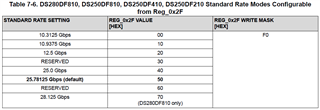Hi Expert,
My customer use DS250DF410 and setting the data rate as 10.3125GHz now.(Setting 0x2F to 00) But they would like to increase the data rate slightly +25ppm.
May I know can DS250DF410 increase the data rate +25ppm when data rate is 10.3125GHz? If can, how can I implement it? Like change which register setting.
Thanks.
Regards,
Roy









